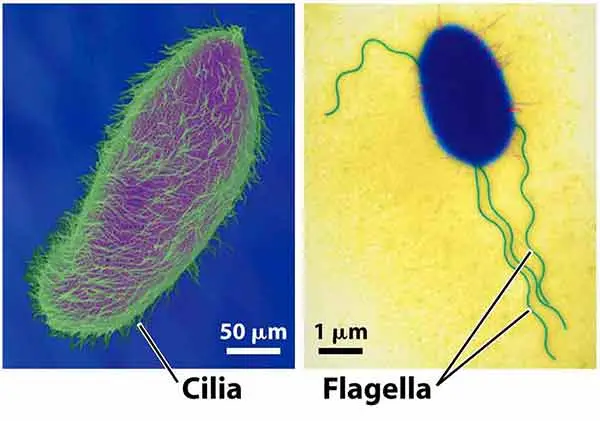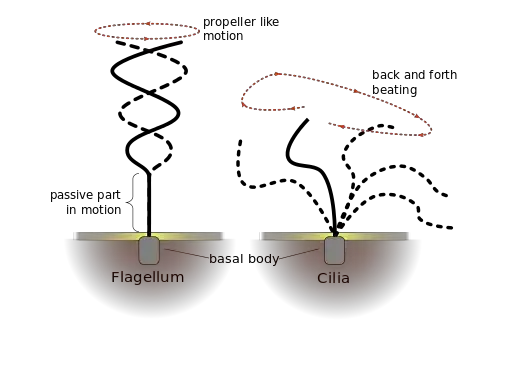What are cilia and flagella?
Cilia as well as Flagella are complex cytoplasmic filamentous structures that protrude through the cell’s wall. They are small, particularly distinct appendices to the cell. The flagella (singular meaning flagellum) are hairy, long structures that extend out from the plasma membrane. They can be utilized to move the entire cell.
Cilia (singular = cilium) are hairy, short structures used to move whole cell types (such such as the paramecia) or other substances on the exterior inside the cells (for instance the cilia of cells that line the Fallopian tubes that push the ovum towards the infected uterus or cilia that line the respiratory tract’s cells that collect particles of matter and then move it towards nasal passages).
The words of cilium (meaning the eyelash) and flagellum (meaning whip) are commonly used arbitrarily. Cilia are generally shorter than flagella (<10 millimeters compared to 40mm or more). Cilia can be found on the exterior of the cell in larger number (ciliated cells typically contain hundreds of cilia, whereas flagellated cells generally contain a single flagellum).
The distinction is in the manner in which their movements. Cilia row as the oars. The motion is biphasic comprised of a powerful stroke where the cilium remains by its rigidity and only bends at the base, and an arc of recovery in which the bend at the base extends toward the end.
Flagella wriggle like eels. They produce waves that travel along their length, generally from tip to base at constant intensity. Therefore, the water’s movement in a flagellum runs perpendicular to its axis, whereas it moves water perpendicularly to its axis, and therefore perpendicularly to the outside inside the cell.
Structure of cilia and flagella
Despite their distinctive patterns in beating as well as flagella are structurally identical. The cilia and flagella are built upon a similar base plan:
- A bundle of microtubules known as the Axoneme (1 up to 2 nm long and 0.2 millimeters in size) is enclosed by a membrane, which forms an integral part of plasma membrane.
- The axoneme is linked to the basal body that constitutes an intracellular cell granule located in the cell cortex is derived from the centrioles.
- Each axoneme is stuffed with the ciliary matrix, within which are two singlet microtubules in the central region each one with protofilaments of 13 and nine other microtubule pairs, referred to as doublets. This motif that is repeated is known as the array 9+2.
- Each doublet has one entire microtubule called”the A subfiber with all 13 protofilaments. Each the A sub fiber, it is an B sub fiber that has 10 protofilaments.
- Subfibre A features two dynein arms that are aligned in a clockwise direction. Doublets are connected through nexin linkages.
- Dynein is an ATPase enzyme that transforms the energy generated through ATP hydrolysis in the effort of flagellar and ciliary beating.
- Each subfiber A is linked to the microtubules in the microtubules that are central by spokes radially, which end up into fork-like structures called spoke knobs , or heads.
The normal arrangement of microtubules as well as related proteins in the nine-way pattern can also be observed in centrioles. But unlike centrioleshowever, flagella and cilia are characterized by a central pair microtubules. This is why the overall structure is referred to as”9+2″ Axoneme.

Notice: Eukaryotic flagella diverge from prokaryotes in their composition. Flagella from eukaryotes have greater amounts of proteins. They also have some similarity to motile cells, with the similar general motion and control patterns.
Working of Cilia and Flagella
In eukaryotes
Utilizing ATP generated by mitochondria close to the cilium’s base or flagellum for fuel the dynein arms press onto the outer doublets and cause an elongation to occur between two outer doublets. Since they are activated within a precise order both around and along the axoneme, and since there is a limit to the extent of sliding can be limited through the spokes radial as well as inter-doublet connections, sliding is transformed into the bending.
In prokaryotes
Bacterial flagella employ a fundamentally different mechanism. Much like the propeller on boats, the movement of the flagellum of a bacterium is completely driven by the motor that rotates at its base. The flagellum of a bacterium is a distinct part of the extracellular cell wall made up of a single protein (flagellin) that bears nothing in common with tubulin nor dynein. Flagella and Cilia are full of cytosol that extends to their tip and utilize the ATP within the cytosol to create forces all along their length.

Functions of Cilia
- Cilia are utilized for locomotion within isolated cells like protozoans (e.g., Paramecium).
- Motile cilia make use of their rhythmic undulations to remove substances, such as dirt, dust microorganisms and mucus to avoid the spread of.
- Cilia are involved within the cycle of cells and the development of animals, for instance in the heart.
- Cilia specifically permit some proteins to perform correctly.
- Cilia can also play a part in molecular communication and cell trafficking.
- Non-motile cilia are a sensor devices for cells, and are able to detect signals. They play a crucial role in the sensory neurons. Non-motile cells are located in the kidneys, which are used to detect the flow of urine, and also within the eyes of photoreceptors in the retina.
- They also provide habitats and places for the symbiotic microbiome to establish itself in animals.
- Cilia have also been found to be involved in the production of the ectosomes.
Functions of Flagella
- Flagella are typically used for moving cells around including the spermatozoon or Euglena (protozoan).
- Flagella play a vital role in supporting the feeding of cells and eukaryotic reproduction.
- In prokaryotes like bacteria, flagella function as propulsion mechanisms. They’re the main way bacteria use to move through the fluids.
- It also serves as a way that allows pathogenic bacteria to assist in colonizing host cells and thus transmitting disease.
- Flagella can also act as scaffolds or bridges to facilitate adhesion to the tissue of the host.
FAQ
Q1. which best describes the difference between protists that have cilia and those that have flagella?
- Those that have cilia are animal-like protists, and those that have flagella are plant-like protists.
- Those that have flagella are animal-like protists, and those that have cilia are plant-like protists.
- Those that have cilia have hair-like extensions for movement, and those that have flagella have a single hair-like extension for movement.
- Those that have cilia are heterotrophs, and those that have flagella are autotrophs.
Ans: C. Those that have cilia have hair-like extensions for movements and those that have flagella have a single hair-like extension for movement.
Protists are organisms that occur in nature as unicellular (one-celled), multicellular, and colonial. This kingdom has subgroups that are the protozoans (animal-like protists), algae (plant-like protists), slime and water molds (fungi-like protists). The protists are being classified according to locomotion (for protozoans) and pigment (for algae). All protists have their own feature for movement. The subgroups under locomotion are ciliates (having cilia or hair-like projections), flagellates (having flagella or long, single hair-like extension), pseudopods, and sporozoans (nonmotile). Ciliates have slower movement compared to flagellates that have faster movements.
Q2. cilia and flagella move due to the interaction of the cytoskeleton with which of the following?
A. Pseudopodia
B. Actin
C. Motor proteins
D. Tubulin
E. Mitochondria
Ans: C. Motor proteins
Q3. how are cilia and flagella different?
Cilia are short, hair like cell organelle extending from the surface of a living cell. While, Flagella are long, threadlike cell organelle present on the surface of a living cell.
Q4. which cytoskeleton fibers are found in cilia and flagella?
Microtubules are the thickest of the cytoskeletal fibers. These are hollow tubes that can dissolve and reform quickly. Microtubules guide organelle movement and are the structures that pull chromosomes to their poles during cell division. They are also the structural components of flagella and cilia.
Q5. what do flagella and cilia have in common?
Flagella and cilia have the same axoneme structure, with nine doublet microtubules organized in a circle around two central singlet microtubules, despite their differing names. Centrioles, like cilia and flagella, are made up of microtubules. Centrioles are microtubule-based hollow cylinders.
Q6. which cytoskeleton fibers are found in cilia and flagella?
Microtubules
Q7. both cilia and flagella are involved in which of the following functions?
Both cilia and flagella serve locomotion functions, but in different manners. Both rely on dynein, which is a motor protein, and microtubules to work.
Q8. what do cilia and flagella do?
The function of cilia is to move water relative to the cell in a regular movement of the cilia. Flagellum is primarily a motility organelle that enables movement and chemotaxis.
Q9. which of the following is a true statement about cilia and flagella?
- Both the cilium and flagellum emerge from basal bodies. – True/false
A basal body can be defined as a protein structure which is found at the base of a eukaryotic undulipodium (cilia or flagella).
It acts as a nucleation site for the growth of the axoneme microtubules.
The basal bodies undergo a transition to form the cytoskeletal structure present in cilia or flagella called the axoneme.
So the correct answer is ‘True’.
Q10. what are cilia and flagella composed of
Cilia and flagella have a core composed of microtubules that are connected to the plasma membrane and arranged in what is known as a 9 + 2 pattern. The pattern is so named because it consists of a ring of nine microtubule paired sets (doublets) that encircle two singular microtubules.
- Text Highlighting: Select any text in the post content to highlight it
- Text Annotation: Select text and add comments with annotations
- Comment Management: Edit or delete your own comments
- Highlight Management: Remove your own highlights
How to use: Simply select any text in the post content above, and you'll see annotation options. Login here or create an account to get started.